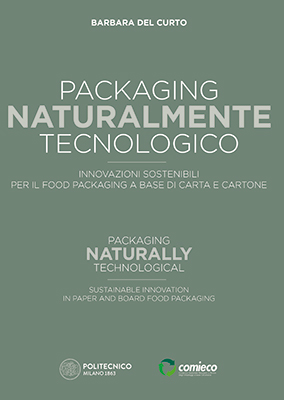Naturally technological packaging
The book’s aim is to identify and describe innovative solutions that are transferable to industry. Innovating with tangible benefits to the consumer and to business, and with appropriate focus on the system’s environmental sustainability is a mission for both the Polytechnic of Milan and Comieco, which with this book chronicle years of shared projects. Barbara Del Curto
 |
Naturally technological packaging Sustainable innovations in paper and board food packaging. New materials, surface treatments, packaging techniques, and solutions performing new functions, in addition to traditional product containment and protection, help define the future scenarios of smart packaging Barbara del Curto |
Many different competencies intersect in the world of packaging, spanning manufacturing, finance, marketing, communication, technology and science. The industry’s multidisciplinary character requires that its players concern themselves with matters ranging from the functionality to the social impact of their products.
Not only new materials, but new ways of designing in a consciously creative and out of the box way. This approach to design is viable in every stage of a packaging solution’s life cycle, but especially at the end when the packaging becomes waste that needs to be processed and managed. In this case the solution is rethinking the design phase by minimizing materials and making them more sustainable and recyclable. The evolution of packaging in recent years has developed so suddenly that the barrier effect is now considered a basic feature, while new innovations aim to implement functional properties. Smart packaging or functional packaging includes all those packaging solutions that make use of a material, surface treatment, packaging technique, etc. to perform additional functions over and above the traditional containment and protection of products.
Paper and board packaging. The advantages made possible by innovations in the paper and board sector have to do with the possibility of chemically altering fibers, lamination with other materials (composites) and special surface treatments.
Today paper and board can be used in place of polymers thanks to enhanced barrier effects against gases combined with active packaging, antimicrobial and photocatalytic properties.
While on one hand the evolution of packaging has led to the development of products offering additional functionalities, i.e. more advanced products, on the other, more environmentally savvy consumers expect manufacturers to reduce a product’s packaging to bare essentials in order to minimize the amount of trash created, in addition to making more natural, disposable packaging that is biodegradable or at least recyclable. Innovation in materials & technology and packaging design are not just a winning combination for a successful product, but a crucial factor to making the sector grow, an expression at the same time of change and of constant innovation. The future of packaging, laden with expectations and bursting with potential, perfectly fits within the circular economy, and the sector will play a leadership role in its development, including in reuse/recycling of materials.

















